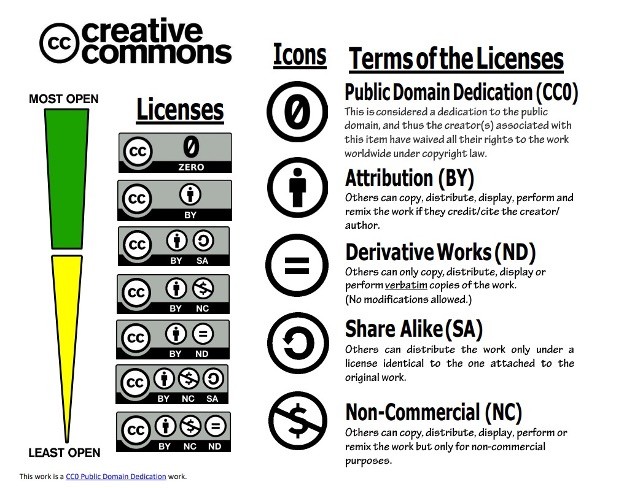This work is licensed under CC BY-NC 4.0
Creative Commons licenses allow copyright holders to retain the copyright to their works while giving the public permission to use those works under certain conditions (Kim, 2007). Furthermore, creative commons licenses allows everyone from individual creators to large institutions a standardized way to grant the public permission to use their creative work under copyright law.
Take a look at the following YouTube video which looks which give a brief over of creative commons licenses
The infographic below demonstrates creative commos licenses from most open to least open

There are six types of creative commons license, the table below give a brief description of each. Alternatively browser through the Creative Commons website to gain a deeper understanding about creative commons
|
This license allows reusers to distribute, remix, adapt, and build on the content in any form or medium as long as credit is given to the creator. The license permits commercial use. CC BY includes the following elements |
|
 |
BY: credit must be given to the creator. |
|
This license allows reusers to distribute, remix, adapt, and build on the material in any medium or format as long as credit is given to the creator. The license allows commercial use. If you remix, adapt, or build on the material, you must license the modified material under the same terms. CC BY-SA includes the following elements |
|
 |
BY: credit must be given to the creator.
SA: Adaptations must be shared under the same terms. |
|
|
This license allows reusers to distribute, remix, adapt, and build on the material in any medium or format for noncommercial purposes only, with attribution to the creator. CC BY-NC contains the following elements. |
 |
BY: credit must be given to the creator.
NC: Only noncommercial uses of the work are permitted. |
|
|
This license allows reusers to distribute, remix, adapt, and build on the material in any medium or format for noncommercial purposes only, with attribution to the creator. If you remix, adapt, or build on the material, you must license the modified version under the same terms. CC BY-NC-SA contains the following elements: |
 |
BY: credit must be given to the creator. NC: Only noncommercial uses of the work are permitted. SA: Adaptations must be shared under the same terms. |
|
|
This license allows reusers to copy and distribute the material in any medium or format in unaltered form, as long as credit is given to the creator. The license allows commercial use. CC BY-ND contains the following elements: |
 |
BY: credit must be given to the creator. ND: No derivatives or adaptations of the work are permitted. |
|
|
This license enables reusers to copy and distribute the material in any medium or format in unadapted form only, for noncommercial purposes only, and only so long as attribution is given to the creator. CC BY-NC-ND includes the following elements: |
 |
BY: credit must be given to the creator. NC: Only noncommercial uses of the work are permitted. ND: No derivatives or adaptations of the work are permitted. |
CC0 (aka CC Zero) is a public dedication tool, which enables creators to give up their copyright and put their works into the worldwide public domain. CC0 enables reusers to distribute, remix, adapt, and build upon the material in any medium or format, with no conditions.

The six licenses and the public domain dedication tool give creators a range of options. The best way to decide which is appropriate for you is to think about why you want to share your work, and how you hope others will use that work.
For help, try the CC license chooser >
Before you apply a CC license or CC0 to your work, there are some important things to consider:
The licenses and CC0 cannot be revoked. This means once you apply a CC license to your material, anyone who receives it may rely on that license for as long as the material is protected by copyright, even if you later stop distributing it.
You must own or control copyright in the work. Only the copyright holder or someone with express permission from the copyright holder can apply a CC license or CC0 to a copyrighted work. If you created a work in the scope of your job, you may not be the holder of the copyright.
See more pre-licensing considerations >
CC-licensing your work is simple. All you have to do is choose the CC license that suits your needs and then communicate this choice in a way that will be clear to people who come across your work. As part of this communication, you should include a link to the license you’ve chosen.
This can be as simple as a bit of text stating and linking to the license in a copyright notice, like this:
© 2019. This work is openly licensed via CC BY 4.0.
…or as complex as embedding the license information on your website using the HTML code associated with the particular license. Use the CC license chooser to get the relevant HTML code.

University of the Western Cape,
Robert Sobukwe Road,
Bellville,
7535
Tel: 021 959 2946
